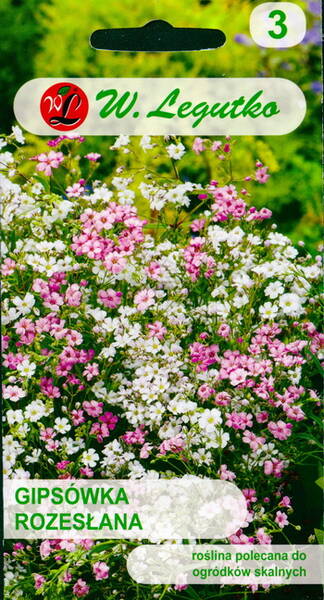Your shopping cart is empty!
Creeping babysbreath "mix"
Creeping babysbreath "mix".
Name: from the Greek words "gypsos" - gypsum and "philos" - friend, translated from Latin: "loving lime". Many species of this genus grow on limestone.
Homeland: mountains of Central Europe.
Perennial herbaceous plant no more than 20 cm tall. The stems are creeping, bare, forming dense bushes. The leaves are narrow-lanceolate, dark green. The flowers are small, white or pink. It blooms in June-July (after a short break, again in autumn). In culture since 1774.
After flowering, it is recommended to trim the shoots to stimulate the regrowth of basal shoots, which are easy to take cuttings. This way you can rejuvenate and propagate the plant.
Gypsophila is unpretentious, but prefers sunny, well-drained areas with loose, non-acidic soil. In snowless winters it freezes, but is perfectly restored by self-sowing. In favorable conditions it grows weeds. Very good for planting on rocky walls.
Location: grows and blooms well in sunny areas, tolerates light shade. When groundwater flows, it dies.
Soil: prefer light sandy loam or loamy, nutritious, well-drained soil containing lime.
Care: the culture is frost-resistant, but it is better to cover young plants with dry leaves for the winter.
Reproduction: by seeds, which are sown in April-May in breeding ridges. In the fall, the seedlings are transplanted to a permanent place, with the calculation of 2-3 plants per square meter.
Without transplantation, perennial species can exist in one place for up to 25 years.
Terry forms are propagated by cuttings and grafting. Young spring shoots are used for cuttings, which are cut in May-June.
The period of cuttings is strictly limited: the rooting rate of gypsophila is relatively low compared to other crops, so careful care is required for the cuttings.
Particular attention should be paid to watering because rooting cuttings do not tolerate excessive dampness.
The grafting of cuttings of double forms is done in the spring by splitting the roots of non-double forms.
Use: mainly for cutting. Gypsophila is good in summer and winter bouquets, perfectly retaining its decorative qualities even in dried form.
Less often they are used for flower decoration in combinations with other plants: in group and single plantings, mixborders.
Partners: marigolds, eschscholzia, godetia.
Name: from the Greek words "gypsos" - gypsum and "philos" - friend, translated from Latin: "loving lime". Many species of this genus grow on limestone.
Homeland: mountains of Central Europe.
Perennial herbaceous plant no more than 20 cm tall. The stems are creeping, bare, forming dense bushes. The leaves are narrow-lanceolate, dark green. The flowers are small, white or pink. It blooms in June-July (after a short break, again in autumn). In culture since 1774.
After flowering, it is recommended to trim the shoots to stimulate the regrowth of basal shoots, which are easy to take cuttings. This way you can rejuvenate and propagate the plant.
Gypsophila is unpretentious, but prefers sunny, well-drained areas with loose, non-acidic soil. In snowless winters it freezes, but is perfectly restored by self-sowing. In favorable conditions it grows weeds. Very good for planting on rocky walls.
Location: grows and blooms well in sunny areas, tolerates light shade. When groundwater flows, it dies.
Soil: prefer light sandy loam or loamy, nutritious, well-drained soil containing lime.
Care: the culture is frost-resistant, but it is better to cover young plants with dry leaves for the winter.
Reproduction: by seeds, which are sown in April-May in breeding ridges. In the fall, the seedlings are transplanted to a permanent place, with the calculation of 2-3 plants per square meter.
Without transplantation, perennial species can exist in one place for up to 25 years.
Terry forms are propagated by cuttings and grafting. Young spring shoots are used for cuttings, which are cut in May-June.
The period of cuttings is strictly limited: the rooting rate of gypsophila is relatively low compared to other crops, so careful care is required for the cuttings.
Particular attention should be paid to watering because rooting cuttings do not tolerate excessive dampness.
The grafting of cuttings of double forms is done in the spring by splitting the roots of non-double forms.
Use: mainly for cutting. Gypsophila is good in summer and winter bouquets, perfectly retaining its decorative qualities even in dried form.
Less often they are used for flower decoration in combinations with other plants: in group and single plantings, mixborders.
Partners: marigolds, eschscholzia, godetia.
Eng.: Creeping babysbreath, creeping baby's breath, trailing baby's breath.












